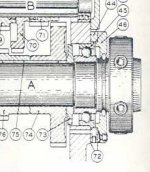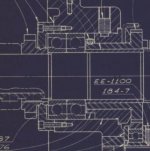AlfaGTA
Diamond
- Joined
- Dec 13, 2002
- Location
- Benicia California USA
I have a 62' EE that i have had apart for some time (years)
Started a rebuild and got distracted.
I am back at it now and questions keep cropping up.
If i measure the depth of the counter bore that carries the flange on the front spindle bearing i get
.1955" to .196" depth in the front bolt on cover.
The original gasket (as removed) measures:
.0295"-.030" (assume original was nominal 1/32" stock
The flange thickness on the bearing measures:
.216"
Looks like this gives total height of counter bore + gasket of :
.2255"
Looks like there is .0095" of clearance between the flange and cover...
Does not seem correct. Anyone here been in this ? Do the numbers seem correct?
Most gasket stock comes in 1/64" steps so even if the gasket was incorrect the next thinner stock would be at 1/64" (.0156" nominal)
Which looks to give around .005" of interference which would mean that the gasket would not be in compression....
Is the factory gasket special (non standard) thickness, or ?????
Seems like one would wish to have the bearing captured for both right hand and left hand thrust.....
Thoughts ?
Cheers Ross
Started a rebuild and got distracted.
I am back at it now and questions keep cropping up.
If i measure the depth of the counter bore that carries the flange on the front spindle bearing i get
.1955" to .196" depth in the front bolt on cover.
The original gasket (as removed) measures:
.0295"-.030" (assume original was nominal 1/32" stock
The flange thickness on the bearing measures:
.216"
Looks like this gives total height of counter bore + gasket of :
.2255"
Looks like there is .0095" of clearance between the flange and cover...
Does not seem correct. Anyone here been in this ? Do the numbers seem correct?
Most gasket stock comes in 1/64" steps so even if the gasket was incorrect the next thinner stock would be at 1/64" (.0156" nominal)
Which looks to give around .005" of interference which would mean that the gasket would not be in compression....
Is the factory gasket special (non standard) thickness, or ?????
Seems like one would wish to have the bearing captured for both right hand and left hand thrust.....
Thoughts ?
Cheers Ross





